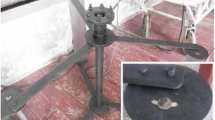Abstract
In this paper, hydrodynamic analysis of vertical axis tidal turbine (both fixed pitch & variable pitch) is numerically analyzed. Two-dimensional numerical modeling & simulation of the unsteady flow through the blades of the turbine is performed using ANSYS CFX, hereafter CFX, which is based on a Reynolds-Averaged Navier-Stokes (RANS) model. A transient simulation is done for fixed pitch and variable pitch vertical axis tidal turbine using a Shear Stress Transport turbulence (SST) scheme. Main hydrodynamic parameters like torque T, combined moment C M , coefficients of performance C P and coefficient of torque C T , etc. are investigated.
The modeling and meshing of turbine rotor is performed in ICEM-CFD. Moreover, the difference in meshing schemes between fixed pitch and variable pitch is also mentioned. Mesh motion option is employed for variable pitch turbine. This article is one part of the ongoing research on turbine design and developments. The numerical simulation results are validated with well reputed analytical results performed by Edinburgh Design Ltd. The article concludes with a parametric study of turbine performance, comparison between fixed and variable pitch operation for a four-bladed turbine. It is found that for variable pitch we get maximum C P and peak power at smaller revolution per minute N and tip sped ratio λ.
Similar content being viewed by others
References
ANSYS CFX Release 13.0 help. Mechanical user guide. Documentation ANSYS Europe, Ltd.
Batten WMJ (2007). Experimentally validated numerical method for the hydrodynamic design of horizontal axis tidal turbines. Journal of Ocean Eng., 34(7), 1013–1020.
Charlier RH (2003). A “sleeper” awakes: tidal current power. Renewable and Sustainable Energy Reviews, 7(6), 515–29.
Coiro DP, Maisto U, Scherillo F, Melone S, Grasso F (2006). Horizontal axis tidal current turbine: Numerical and experimental investigations. Proceedings of the OWEMES, Civitavecchia, Italy, 20–22.
Drees HM (1978). The Cycloturbine and its Potential for Broad Application. 2 nd International Symposium on Wind Energy Systems, 3–6, E7-82–E7-88.
Edinburgh Design Ltd (2006). Variable pitch foils vertical axis tidal turbine final report. Project T/06/00234/00/00.Available at http://webarchive.nationalarchives.gov.uk/+/http://www.berr.gov.uk/files/file30557.pdf [accessed on 05-06-2012]. GCK Technology. http://www.lucidenergy.com/gck [accessed on 04.04.2012].
Golecha K, Eldho TI, Prabhu SV (2012). Study on the interaction between two hydrokinetic savonius turbines. Journal of Rotating Machinery, 2012 (2012), 1–10.
Hyman JM, Knapp R, Scovel JC (1992). High order finite volume approximations of differential operators on non-uniform grids. Physica D, 60, 112–138.
Khan M, Bhuyan G, Iqbal M, Quaicoe J (2009). Hydrokinetic energy conversion systems and assessment of horizontal and vertical axis turbines for river and tidal applications: a technology status review. Journal of Applied Energy, 86(10), 1823–1835.
Kirke BK, Lazauskas L (2011). Limitations of fixed pitch Darrieus hydrokinetic turbines and the challenge of variable pitch. Journal of renewable energy, 36, 893–897.
Lazauskas L, Kirke BK (2012). Modeling passive variable pitch cross flow hydrokinetic turbines to maximize performance and smooth operation. Journal of Renewable Energy, 45, 41–50.
McConnell RD (1979). Giro-mill overview. Wind Energy Innovative Systems Conference, Colorado Springs, USA, 1–14.
Meikle PJ (1993). A Family of novel vertical axis wind Turbines. Univ. of Melbourne, Melbourne.
Menter, FR (1994). Two-Equation Eddy-viscosity turbulence models for engineering applications. AIAA Journal, 32(8), 1598–1605.
Pawsey NCK (2002). Development and evaluation of passive variable-pitch vertical axis wind turbines. PhD Thesis, The University of New South Wales, Kingsford, Australia.
Rourke FO, Boyle F, Reynolds A (2009). Renewable energy resources and technologies applicable to Ireland. Renewable and Sustainable Energy Rev, 13(8), 1975–1984.
Salvatore F, Greco L, Calcagno G. A Theoretical & computational methodology to study vertical-axis turbines hydrodynamics. (http://192.107.92.31/test/owemes/34.pdf [accessed on: 12.04.2012]
Shikha S, Bhatti TS, Kothari DP (2005). Early development of modern vertical and horizontal axis wind turbines: a review. Journal of Wind Engineering, 29(3), 287–300.
Sun Y, Zhang L (2012). Airfoil optimization of vertical-axis turbines based on CFD method. 2 nd International Conf. on Computer Modeling & Simulation, 199–202.
Zanette J, Imbault D, Tourabi A (2010). A design methodology for cross flow water turbines. Journal of Renew Energy, 35(5), 997–1009.
Author information
Authors and Affiliations
Corresponding author
Additional information
Foundation item: This research is financially supported by National “863” Program (Grant No.2007AA05Z450, No. 200805040), National S&T Program (No.2008BAA15B04), 2010 National Ocean Special Funds (No.ZJME2010GC01, No. ZJME2010CY01, No.GHME2010GC02). And it is supported by the Fundamental Research Funds of the Universities (No.HEUCF130105). And it is also supported by “111 project” foundation (No. B07019) from State Administration of Foreign Experts Affairs of China and Ministry of Education of China.
Qihu Sheng was born in 1974. He received his PhD Degree in Fluid Mechanics from Harbin Engineering University.He is an associate professor at Harbin Engineering University. His current research interests include hydrodynamics, ocean renewable energy utility technology, design and analysis on mooring system of ocean energy power station.
Syed Shah Khalid was born in Peshawar Pakistan. He is a PhD candidate at Shipbuilding College, Harbin Engineering University. His current research interests include CFD, renewable energy & structural analysis of marine structures.
Zhimin Xiong is a senior engineer. He is engaged in the professional: wind turbine system, photovoltaic power system, wind turbine system. His research interests include wind power, new energy, etc.
Liang Zhang is a renowned Professor and PhD supervisor at Shipbuilding College. He is also the Vice Director of Deep water Research Center at Shipbuilding College, Harbin Engineering University. His current research interests include fluid mechanics, renewable energy, off-shore hydrodynamics & development of tidal turbines.
Rights and permissions
About this article
Cite this article
Sheng, Q., Khalid, S.S., Xiong, Z. et al. CFD simulation of fixed and variable pitch vertical axis tidal turbine. J. Marine. Sci. Appl. 12, 185–192 (2013). https://doi.org/10.1007/s11804-013-1184-z
Received:
Revised:
Published:
Issue Date:
DOI: https://doi.org/10.1007/s11804-013-1184-z



